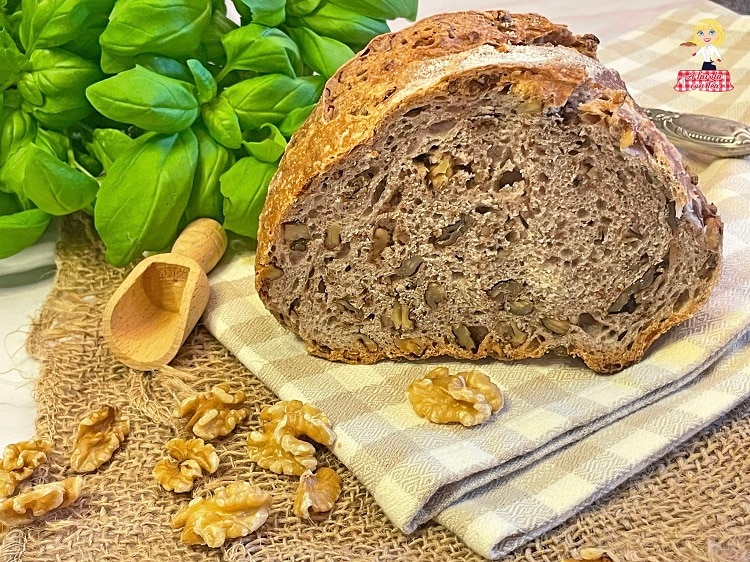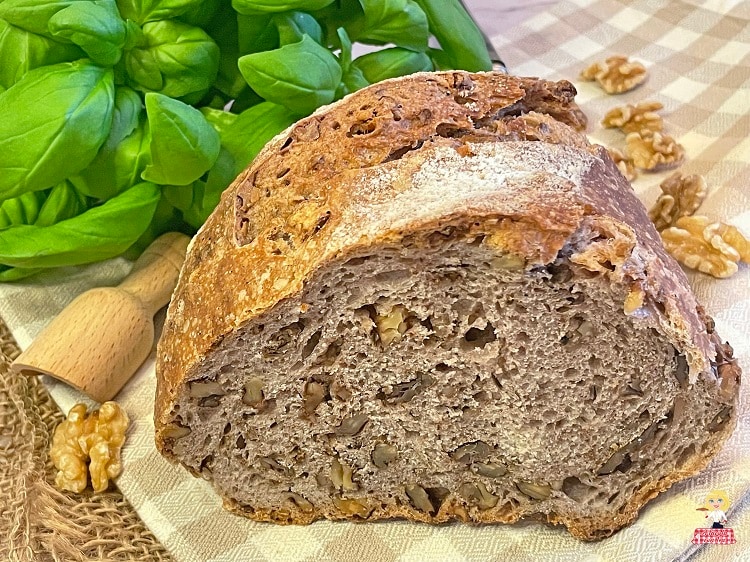Walnut Bread
Walnut bread is a rustic and tasty leavened bread, a variant of the classic homemade bread enriched with pieces of chopped walnut in the dough that give it a unique crunchiness and aroma.
I confess to being a walnut lover and consequently, any recipe that includes them as an ingredient drives me crazy. So, while browsing Fulvio Marino’s book, I came across this Walnut bread recipe and couldn’t pass it up.
The recipe for Walnut bread is simpler than it seems and is suitable even for beginners. It can be prepared without a mixer or planetary mixer, simply in a bowl, and requires just a bit of patience before tasting due to the dough’s resting times.
The ingredients are the classic ones for bread: flour, water, salt, yeast, and walnut pieces.
After a first rise and after giving the dough some folds, it then moves on to a second rise until it doubles before baking, where after just over 40 minutes, you’ll take out a classic loaf with a crispy crust and a unique flavor given by the presence of walnuts: you’ll love it at first bite!
Great to enjoy on its own or even better paired with cold cuts and cheeses, grilled vegetables, or as a substitute for regular table bread, or even for a delightful breakfast spread with a thin layer of jam.
An additional advantage of this Walnut Bread is that it lasts a few days if stored in a cool and dry place. Just remove a thin initial slice, and it will be as if freshly baked. And when it loses its natural softness, it’ll be perfect for toasting.
But let’s now see all the steps to prepare it together.
related recipes:

- Difficulty: Medium
- Cost: Cheap
- Rest time: 4 Hours
- Preparation time: 30 Minutes
- Portions: 6
- Cooking methods: Oven
- Cuisine: Italian
- Energy 157.41 (Kcal)
- Carbohydrates 22.97 (g) of which sugars 0.81 (g)
- Proteins 5.52 (g)
- Fat 4.86 (g) of which saturated 0.02 (g)of which unsaturated 0.05 (g)
- Fibers 3.16 (g)
- Sodium 278.99 (mg)
Indicative values for a portion of 2 g processed in an automated way starting from the nutritional information available on the CREA* and FoodData Central** databases. It is not food and / or nutritional advice.
* CREATES Food and Nutrition Research Center: https://www.crea.gov.it/alimenti-e-nutrizione https://www.alimentinutrizione.it ** U.S. Department of Agriculture, Agricultural Research Service. FoodData Central, 2019. https://fdc.nal.usda.gov
Ingredients
- 2 1/3 cups whole wheat flour
- 1 1/4 cups spelt flour
- 1/3 cup buckwheat flour
- 1 cup walnut kernels
- 1 1/2 cups water (lukewarm)
- 1 tsp dry yeast
- 2 tsp fine salt
Tools
- Stand mixer
- Baking sheet
Note
If you don’t have a stand mixer, you can knead by hand following the same order of ingredients.
Place the three types of flour and the dry yeast in the bowl of the stand mixer or mixer (use the hook). Set the mixer to moderate speed and gradually pour in the water. Continue kneading for about 8 minutes until you get a well-incorporated dough (it should detach from the hook on its own).
Add the salt and walnuts and continue at medium speed until they are fully incorporated into the dough. At this point, transfer the dough to a lightly floured surface and fold the mixture by stretching and folding it over itself. Form a ball and let it rest in a bowl covered with cling film for about 4 hours. It should double in size.
After the resting time, transfer the dough to a work surface, knead it quickly, and shape it into a loaf. Place it on a baking tray lined with parchment paper and let it rise for another hour. After rising, make cuts on the surface, not too deep, with a very sharp knife. Bake at 464°F (240°C) in a preheated static oven for 20 minutes, then lower the temperature to 428°F (220°C) and bake for another 20 minutes. Remove it and let it cool slightly before slicing and serving.

TIPS
The rising times are indicative because they depend on the season and consequently the room temperature. Consider that the dough is ready when it has doubled in size.
To get better bread with a well-aerated crumb, I recommend placing a bowl with a little water on the lower oven rack at the start of baking, which you will remove after 20 minutes when you lower the oven temperature. This will create the right humidity inside the oven.
If you prefer, you can replace the walnuts with hazelnuts for sweeter and more delicate bread or olives for more aromatic and flavorful bread.
STORAGE
Once baked, the walnut bread can be stored at room temperature in a cool, dry place in a bag for up to 3-4 days. Alternatively, you can cut it into pieces and freeze it for later use; just defrost and warm it slightly in the oven or microwave.

